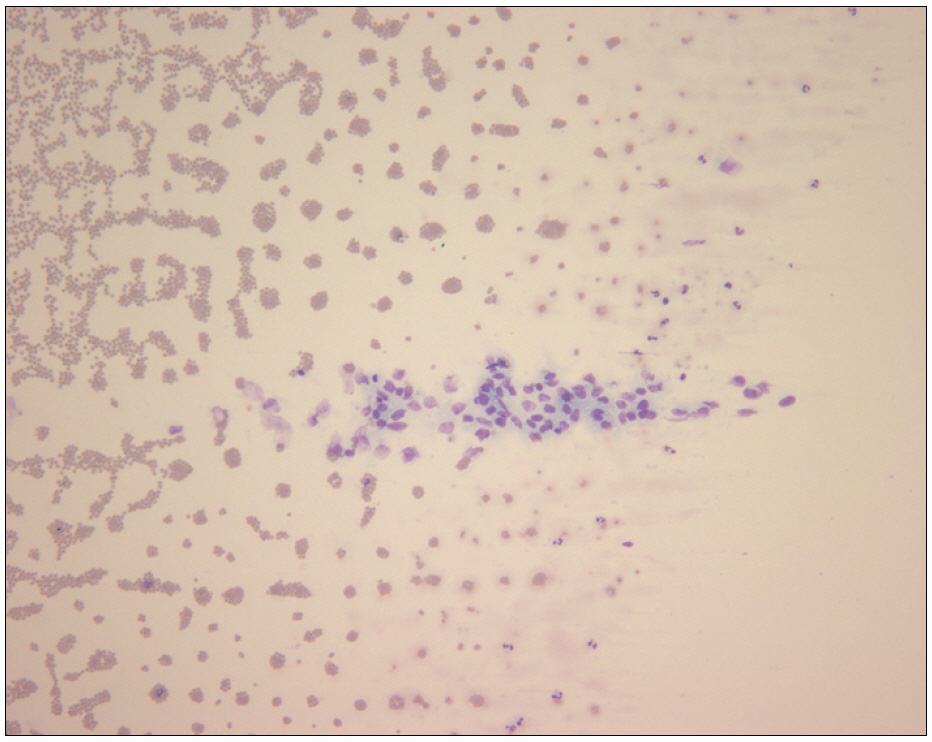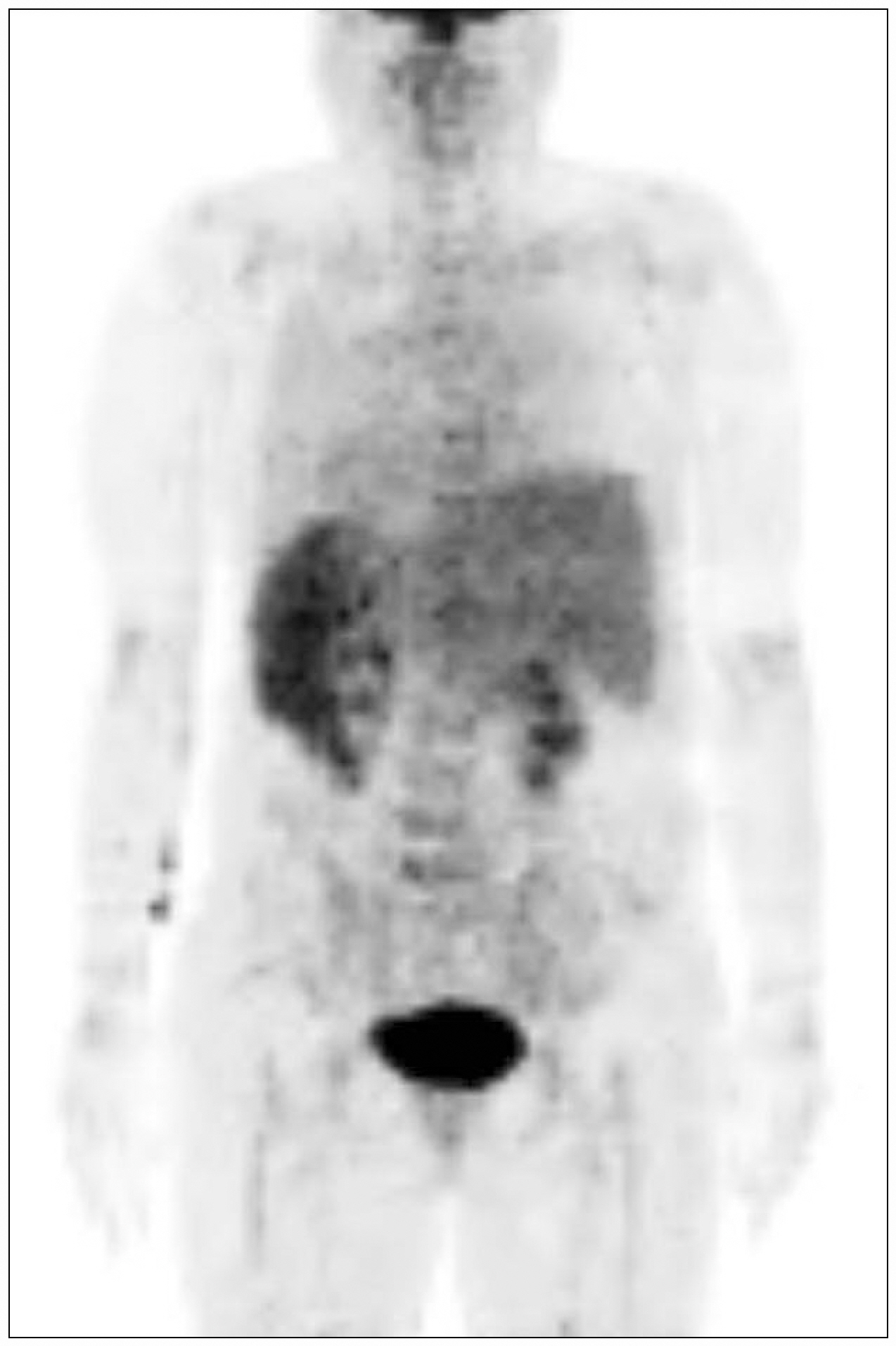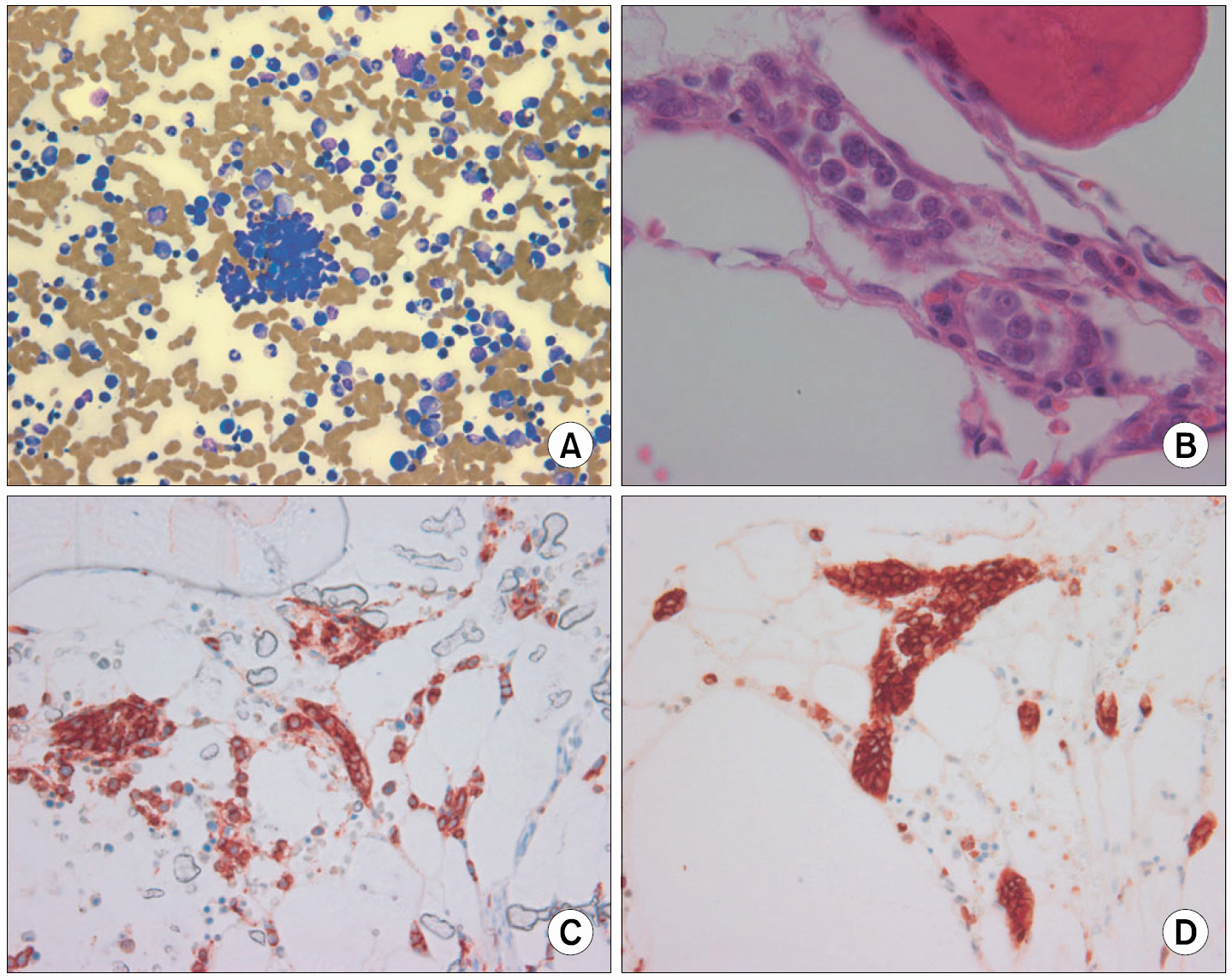Korean J Hematol.
2006 Dec;41(4):306-310. 10.5045/kjh.2006.41.4.306.
Intravascular Large B-cell Lymphoma with Bone Marrow Involvement: A Case Successfully Treated with a Rituximab-CHOP Combination Regimen
- Affiliations
-
- 1Department of Internal Medicine, Research Institute of Clinical Medicine, Chonbuk National University Medical School, Jeonju, Korea. eksong@chonbuk.ac.kr
- KMID: 2305219
- DOI: http://doi.org/10.5045/kjh.2006.41.4.306
Abstract
- Intravascular large B-cell lymphoma is rare and generally fatal. It is defined pathologically by neoplastic proliferation of lymphoid cells within the lumens of capillaries, small veins, and arteries with little or no other parenchymal involvement. The diagnosis can be delayed because of the rarity of the disease and the difficulty of detection in imaging studies, and a suspicious clinical observation is warranted to make the correct diagnosis. Early diagnosis is important because delayed treatment could result in a fatal outcome. We have encountered a case of intravascular large B-cell lymphoma involving only the bone marrow. An early diagnosis was made and the patient was treated with combination chemotherapy and rituximab targeting CD20. The patient went into complete remission after the third cycle of chemotherapy and maintained a disease free state up to 6 months.
MeSH Terms
Figure
Reference
-
1). Stroup RM., Sheibani K., Moncada A., Purdy LJ., Battifora H. Angiotropic (intravascular) large cell lymphoma: a clinicopathologic study of seven cases with unique clinical presentations. Cancer. 1990. 66:1781–8.
Article2). Pfleger L., Tappeiner J. Zur Kenntnis der system-isierten Endotheliomatose der cutanen Blutgefasse. Hautarzt. 1959. 10:359–63.3). Han BI., Bae MC., Hong JM., Huh K., Han JH. Intravascular lymphomatosis in central nervous system. J Korean Neurol Assoc. 2001. 19:413–6.4). Park HD., Park J., Kim SH., Kim J., Kim HT., Kim MH, et al. Intravascular lymphomatosis presenting as demyelinating disease: a case report. J Korean Neurol Assoc. 2004. 22:535–8.5). Park BB., Kim KH., Son JS, et al. Intravascular lymphomatosis presenting as fever of unknown origin with peripheral polyneuropathy. Infection and Chemotherapy. 2003. 35:355–9.6). Kim JS., Kim TY., Sun JM, et al. Intracranial relapses of intravascular large B-cell lymphoma after completion of CHOP chemotherapy. Korean J Heamatol. 2004. 39:177–81.7). Kim CS., Park YT., Park TH., Yoo JH., Kim KJ. A case of intravascular large B cell lymphoma. Korean J Dermatol. 2004. 42:223–5.8). Lee SI., Kim WS., Lee J, et al. Two cases of intravascular lymphomatosis. Korean J Heamatol. 2002. 37:138–42.9). Park SJ., Bae SS., Cheon EM, et al. A case of pulmonary intravascular lymphomatosis. Tuberc Repirato-ry Dis. 1997. 44:1390–5.
Article10). Suh CH., Kim SK., Shin DH., Chung KY. Intravascular lymphomatosis of the T cell type presenting as interstitial lung disease-a case report. J Korean Med Sci. 1997. 12:457–60.
Article11). Ponzoni M., Arrigoni G., Gould VE, et al. Lack of CD29 (beta1 integrin) and CD54 (ICAM-1) adhesion molecules in intravascular lymphomatosis. Hum Pa-thol. 2000. 31:220–6.12). Cheng FY., Tsui WM., Yeung WT., Ip LS., Ng CS. Intravascular lymphomatosis: a case presenting with encephalomyelitis and reactive haemophagocytic syndrome diagnosed by renal biopsy. Histopathology. 1997. 31:552–4.
Article13). Berger TG., Dawson NA. Angioendotheliomatosis. J Am Acad Dermatol. 1988. 18:407–12.
Article14). Asagoe K., Fujimoto W., Yoshino T, et al. Intravascular lymphomatosis of the skin as a manifestation of recurrent B-cell lymphoma. J Am Acad Dermatol. 2003. 48(2 Suppl):S1–4.
Article15). Bouzani M., Karmiris T., Rontogianni D, et al. Disseminated intravascular B-cell lymphoma: clinicopathological features and outcome of three cases treated with anthracycline-based immunochemotherapy. Oncologist. 2006. 11:923–8.
Article
- Full Text Links
- Actions
-
Cited
- CITED
-
- Close
- Share
- Similar articles
-
- Primary Isolated Bone Marrow Diffuse Large B-cell Lymphoma with Hemolytic Anemia as the First Manifestation
- A Case of Primary Bone Lymphoma with Multifocal Bone Involvement
- A Case of Mantle Cell Lymphoma Treated with Autologous Stem Cell Transplantation and Rituximab
- Primary diffuse large B-cell lymphoma of the bone marrow in a frail and elderly patient successfully treated with rituximab, cyclophosphamide, doxorubicin, vincristine, and prednisone
- Patterns of Neutropenia and Risk Factors for Febrile Neutropenia of Diffuse Large B-Cell Lymphoma Patients Treated with Rituximab-CHOP




